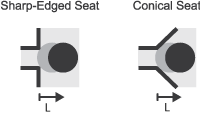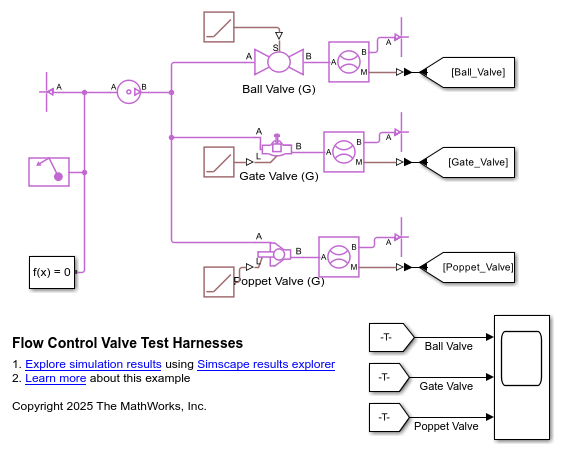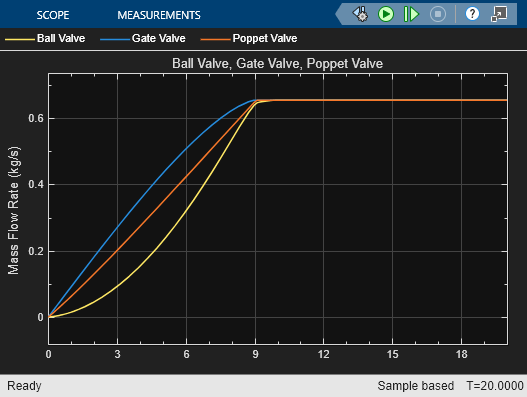Poppet Valve (G)
Poppet valve in a gas network
Libraries:
Simscape /
Fluids /
Gas /
Valves & Orifices /
Flow Control Valves
Description
The Poppet Valve (G) block represents an orifice with a translating ball that moderates flow through the valve. In the fully closed position, the ball rests at the perforated seat, and fully blocks the fluid from passing between ports A and B. The area between the ball and seat is the opening area of the valve.
The flow can be laminar or turbulent, and it can reach up to sonic speeds. The maximum velocity happens at the throat of the valve where the flow is narrowest and fastest. The flow chokes and the velocity saturates when a drop in downstream pressure can no longer increase the velocity. Choking occurs when the back-pressure ratio reaches the critical value characteristic of the valve. The block does not capture supersonic flow.
Ball Mechanics
The block models the displacement of the ball but not the valve opening or closing dynamics. The signal at port L provides the normalized ball position, L. Note that L is a normalized distance between 0 and 1, which indicate a fully closed valve and a fully open valve, respectively. If the calculation returns a number outside of this range, that number is set to the nearest bound.
When the Smoothing factor parameter is nonzero, the block applies numerical smoothing to the normalized ball position, L. Enabling smoothing helps maintain numerical robustness in your simulation.
For more information, see Numerical Smoothing.
Opening Area
The opening area of the valve depends on the Valve seat geometry
parameter, which can be either Sharp-edged or
Conical. The Leakage flow
fraction parameter is the ratio of the flow rate of the valve when it
is closed to when it is open. The Leakage flow fraction allows
for small contact gaps between the ball and seat in the fully closed position. This
parameter also maintains continuity in the flow for solver performance.
This figure shows the seat types for the poppet valve.

The block calculates the opening area of the valve as
where:
h is the distance between the outer edge of the cylinder and the seat.
rO is the seat orifice radius, which the block calculates from the Orifice diameter parameter.
rB is the radius of the ball, which the block calculates from the Ball diameter parameter.
Gsharp is the geometric parameter:
The maximum displacement, hmax, bounds the opening area:
For any ball displacement larger than hmax, Sopen is the value of the maximum orifice area:
When the signal at port L is less than 0, the valve is closed and the Leakage flow fraction parameter determines the mass flow rate.
The block calculates the opening area of the valve as:
where:
h is the vertical distance between the outer edge of the cylinder and the seat.
θ is the value of the Cone angle parameter.
Gconical is the geometric parameter, where rB is the ball radius.
The maximum displacement, hmax, bounds the opening area:
For any ball displacement larger than hmax, Sopen is the value of the maximum orifice area:
When the signal at port L is less than 0, the valve is closed and the Leakage flow fraction parameter determines the mass flow rate.
Valve Parameterizations
The block behavior depends on the Valve parametrization parameter:
Cv flow coefficient— The flow coefficient Cv determines the block parameterization. The flow coefficient measures the ease with which a gas can flow when driven by a certain pressure differential.Kv flow coefficient— The flow coefficient Kv, where , determines the block parameterization. The flow coefficient measures the ease with which a gas can flow when driven by a certain pressure differential.Sonic conductance— The sonic conductance of the resistive element at steady state determines the block parameterization. The sonic conductance measures the ease with which a gas can flow when choked, which is a condition in which the flow velocity is at the local speed of sound. Choking occurs when the ratio between downstream and upstream pressures reaches a critical value known as the critical pressure ratio.Orifice area based on geometry— The size of the flow restriction determines the block parametrization.
The block scales the specified flow capacity by the fraction of valve opening. As the
fraction of valve opening rises from 0 to 1,
the measure of flow capacity scales from its specified minimum to its specified
maximum.
Mass Flow Rate
The block equations depend on the Orifice parametrization parameter.
When you set Orifice parametrization to Cv
flow coefficient parameterization, the mass flow rate, , is
where:
Cv is the value of the Maximum Cv flow coefficient parameter.
Sopen is the valve opening area.
SMax is the maximum valve area where the valve is fully open.
N6 is a constant equal to 27.3 for mass flow rate in kg/hr, pressure in bar, and density in kg/m3.
Y is the expansion factor.
pin is the inlet pressure.
pout is the outlet pressure.
ρin is the inlet density.
The expansion factor is
where:
Fγ is the ratio of the isentropic exponent to 1.4.
xT is the value of the xT pressure differential ratio factor at choked flow parameter.
The block smoothly transitions to a linearized form of the equation when the pressure ratio, , rises above the value of the Laminar flow pressure ratio parameter, Blam,
where:
When the pressure ratio, , falls below , the orifice becomes choked and the block switches to the equation
When you set Orifice parametrization to Kv flow
coefficient parameterization, the block uses these same
equations, but replaces Cv with
Kv by using the relation . For more information on the mass flow equations when the
Orifice parametrization parameter is Kv
flow coefficient parameterization or Cv flow
coefficient parameterization, see [2][3].
When you set Orifice parametrization to Sonic
conductance parameterization, the mass flow rate, , is
where:
C is the value of the Maximum sonic conductance parameter.
Bcrit is the critical pressure ratio.
m is the value of the Subsonic index parameter.
Tref is the value of the ISO reference temperature parameter.
ρref is the value of the ISO reference density parameter.
Tin is the inlet temperature.
The block smoothly transitions to a linearized form of the equation when the pressure ratio, , rises above the value of the Laminar flow pressure ratio parameter Blam,
When the pressure ratio, , falls below the critical pressure ratio, Bcrit, the orifice becomes choked and the block switches to the equation
The Sonic conductance setting of the
Valve parameterization parameter is for pneumatic
applications. If you use this setting for gases other than air, you may need to
scale the sonic conductance by the square root of the specific gravity.
For more information on the mass flow equations when the Orifice
parametrization parameter is Sonic conductance
parameterization, see [1].
When you set Orifice parametrization to
Orifice area based on geometry, the mass flow
rate, , is
where:
Sopen is the valve opening area.
S is the value of the Cross-sectional area at ports A and B parameter.
Cd is the value of the Discharge coefficient parameter.
γ is the isentropic exponent.
The block smoothly transitions to a linearized form of the equation when the pressure ratio, , rises above the value of the Laminar flow pressure ratio parameter, Blam,
When the pressure ratio, , falls below , the orifice becomes choked and the block switches to the equation
For more information on the mass flow equations when the Orifice
parametrization parameter is Orifice area based on
geometry, see [4].
Energy Balance
The resistive element of the block is an adiabatic component. No heat exchange can occur between the fluid and the wall that surrounds it. No work is done on or by the fluid as it traverses from inlet to outlet. Energy can flow only by advection, through ports A and B. By the principle of conservation of energy, the sum of the port energy flows is always equal to zero
where ϕ is the energy flow rate into the valve through ports A or B.
Mass Balance
The block assumes the volume and mass of fluid inside the valve is very small and ignores these values. As a result, no amount of fluid can accumulate in the valve. By the principle of conservation of mass, the mass flow rate into the valve through one port equals that out of the valve through the other port
where is defined as the mass flow rate into the valve through the port indicated by the A or B subscript.
Assumptions and Limitations
The equation for the
Orifice area based on geometryparameterization is less accurate for gases that are far from ideal.This block does not model supersonic flow.
Examples
Ports
Conserving
Input
Parameters
References
[1] ISO 6358-3. "Pneumatic fluid power – Determination of flow-rate characteristics of components using compressible fluids – Part 3: Method for calculating steady-state flow rate characteristics of systems". 2014.
[2] IEC 60534-2-3. "Industrial-process control valves – Part 2-3: Flow capacity – Test procedures". 2015.
[3] ANSI/ISA-75.01.01. "Industrial-Process Control Valves – Part 2-1: Flow capacity – Sizing equations for fluid flow underinstalled conditions". 2012.
[4] P. Beater. Pneumatic Drives. Springer-Verlag Berlin Heidelberg. 2007.


